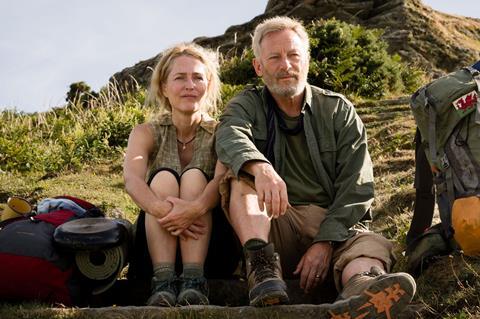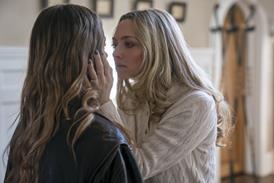Marianne Elliott’s faltering move to the big screen stars Jason Isaacs and Gillian Anderson

Dir. Marianne Elliott. UK. 2024. 115mins
Theatre director Marianne Elliott’s laborious feature directorial debut The Salt Path has too light a touch to give the long journey undertaken by homeless couple Ray (Gillian Anderson) and Moth (Jason Isaacs), who has been diagnosed with a terminal neurodegenerative disease, sufficient weight. Adapted from Raynor Winn’s memoir of the same name, the story of their walking trip on the South West Coast Path – the longest National Trail in England – takes us to many places, yet offers few memorable moments.
The film feels uncomfortably aware of its minimal drama.
The film, in fact, feels uncomfortably aware of its minimal drama. The picture begins in media res with fractal images of Ray and Moth fighting against the ocean’s tide to save their tent. Rebecca Lenkiewicz’s script then takes a winding, non-linear route to explain how Ray and Moth ended up here. Once farmers, they lost their home and their liveliehood after a bad investment by Moth. Rather than wallow in their misfortune, Ray and Moth packed up and hit the road to Land’s End. They hope the 630-mile trek will give them time to plan for a new future, grapple with their debt, fix their homelessness – and distract Moth from his debilitating disease. The film spends much of its time building back to that opening scene, only for its conclusion to be decidedly anti-climactic.
Through its focus on economically displaced people traversing a country during the autumn of their lives, The Salt Path often recalls Chloé Zhao’s Best Picture winner Nomadland. Unlike that emotionally rich film, The Salt Path, which premiered at Toronto, fails to build a thriving world outside of its protagonists. Despite its inspirational material and sturdy stars, The Salt Path will struggle to capture the same indie hearts Zhao managed to hold.
Part of the problem is that what and who Ray and Moth encounter on their journey around England’s south west coast isn’t enough to sustain a nearly two-hour runtime. They amble through verdant, windswept valleys, down a luminous coastline and against stormy conditions as they jump from small town to small town. Beautifully lensed by Helene Louvart (La Chimera), these landscapes are vivid, textural settings marked by natural elegance and looming danger that mirrors the earthy poetry of Seamus Heaney (Moth is often seen reading Heaney’s Beowulf translation throughout the film). Since they’re usually flat broke, Ray and Moth are often eating noodles or subsisting on water. Sometimes crabby passersby will tell them to go pitch their tent somewhere else, other times they receive a helping hand from a young couple in love or a shirtless guy picking berries. Hilariously, people mistaking Moth for a famous poet often nets the couple some extra perks too.
The film treats all of these occurrences as minor events, hoping the subtlety of their delivery will give rise to profundity. Ray and Moth spend much of their travels mourning the life they once enjoyed, and thinking about how their grown son and daughter are getting on in the world. The simple act of Ray looking up to the sky, soaking its salty air on her face, offers meaning to her and glimpses of poeticism to the viewer. They’re both also grappling with Moth’s recent diagnosis of CBD (Corticobasal Degeneration), a degenerative and life-threatening condition that has caused the left side of his body to seize up. These themes ebb and flow like a soft wave, remaining ever-present without ever overwhelming Elliott’s naturalistic storytelling.
Elliott further sustains the film’s quiet approach by leaning on Anderson and Isaacs, who, save for Anderson once again adopting a British accent, are physically and emotionally unvarnished. Anderson’s face becomes leathered and sunburned, while Isaacs allows his hair to grey during the film. Neither actor opts for broad movements or easy artifice to carry their respective performance. In fact, they’re quite caved-in, their bodies withdrawing from the world in the same way the world –social services, the legal system, and their friends — has abandoned them. These performances alone would be enough to sustain this film, if it weren’t so elusive.
The Salt Path stands as Elliott’s jump from the West End to film-making. And while her work with these two actors is exceptional, showcasing how these characters are informed by the people they meet along the way and the travesties that befall them is somewhat lacking. The latter weakness causes the film to wander, making it too reserved to take us anywhere emotionally satisfying.
Production companies: Number 9 Films, Elliott and Harper Productions, BBC Film, LipSync Productions, Shadowplay Features, Rocket Science
International sales: Rocket Science, info@rocket-science.net
Producers: Elizabeth Karlsen, Stephen Woolley, Lloyd Levin, Beatriz Levin
Screenplay: Rebecca Lenkiewicz
Cinematography: Helene Louvart
Production design: Christina Moore
Editing: Lucia Zuchetti, Gareth C Scales
Music: Chris Roe
Main cast: Jason Isaacs, Gillian Anderson, James Lance, Hermione Norris





















